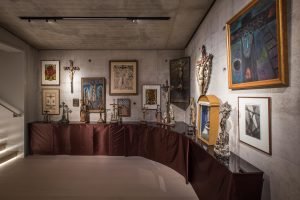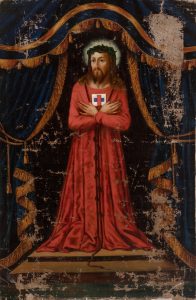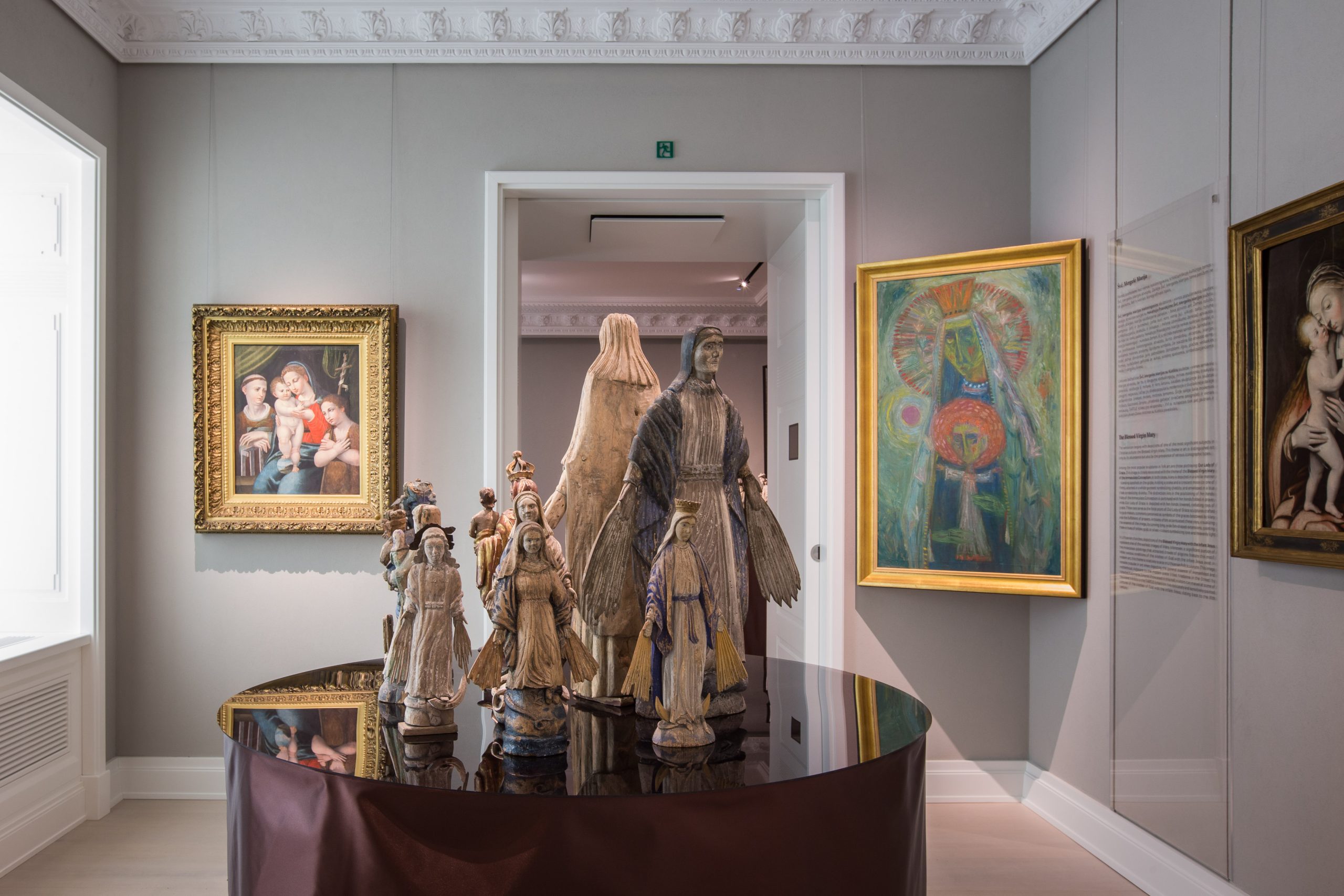The Lithuanian Art Centre TARTLE has opened a new exhibition titled “Solely Saints” today, offering a captivating exploration of Christian imagery in both folk and professional art. The exhibition features saints depicted in works from the 16th century alongside those created by contemporary artists.
The collection includes pieces crafted by artists with years of professional training and works by self-taught village god-makers who expressed their faith through their unique styles and methods. As the seventh exhibition at TARTLE, it showcases part of the world’s largest publicly available private collection of Lithuanian folk art. Visitors will also find rare early church art, works by modernists, classics of Lithuanian art, and pieces from emerging artists.
In the exhibition halls, curators Dr. Skaidrė Urbonienė and Emilija Vanagaitė have crafted a fragmentary narrative highlighting Lithuanian folk Christian art’s most important iconographic themes. These themes range from expressions of universal pain (Pieta, Christ in Distress, the Crucifixion) to Christian love and hope (Our Lady of Grace), the fight against evil (St George), repentance (St Mary Magdalene), and local images significant to Lithuanian religious and national identity (Our Lady of the Gates of Dawn, Our Lady of Šiluva, St Casimir).

The earliest works of religious art from the 16th century
The exhibition opens with one of the most significant themes in Christian culture: images of the Blessed Virgin Mary. Among the highlights are two 16th-century paintings by unknown artists, a rarity in Lithuania. These early works are displayed alongside modern and contemporary pieces on the same subject, such as a wooden panel painting of the Blessed Virgin Mary and the Infant Christ juxtaposed with a contemporary interpretation created using aerosol paint. These chronological and technical contrasts emphasise the timeless beauty of Christian symbols.
Gods crafted by god-makers
According to Lithuanian folk-art expert and exhibition curator Dr. Skaidrė Urbonienė, since the era of national revival, many Lithuanian artists and cultural figures have shown a keen interest in folk art, collecting and capturing examples in paintings and photographs. In 1908, Mikalojus Konstantinas Čiurlionis remarked that Lithuanian folk art “is our pride due to its pure, distinctive, and exclusively Lithuanian beauty.”
“This fascination with folk art, especially the statuettes crafted by god-makers, known as ‘little gods,’ persisted through the interwar years and the Soviet era. Many artists amassed collections of these statuettes, large or small. Painters, graphic artists, and sculptors often drew inspiration from these collections, seeking ideas, motifs, and visual solutions in their iconography and forms,” says Urbonienė.
Exhibition highlights: Christ in Distress and Jesus of Nazareth
TARTLE founder and collector Rolandas Valiūnas notes that while many of us are familiar with various saints, there are often intriguing details we might not know. For instance, during the interwar period, it was decided that the figure of Christ in Distress would represent Lithuania abroad. Despite some criticism of this sorrowful choice, this figure captured attention and became a symbol of Lithuania at the 1937 World Exhibition in Paris. The oak sculpture of Christ in Distress, nearly 3 metres tall and created according to a project by sculptor Juozas Mikėnas, is highlighted in a photograph displayed in the exhibition.

Another highlight is a collection of ten images of Jesus of Nazareth, inspired by the 1.90-meter-tall statue standing in St. Peter and Paul’s Church, a popular site for locals and visitors. The history of this statue is fascinating: “Originally, it belonged to the Vilnius Trinitarian Church of Jesus of Nazareth, endowed by the Sapiehas. During the sanctuary’s construction in 1700, the Trinitarians of Rome commissioned and sent the head and hands of the statue to Vilnius while the body was crafted locally. In 1864, after the tsarist authorities closed the Antakalnis Trinitarian monastery and church, the statue of Jesus of Nazareth was transferred to the nearby St. Peter and Paul’s Church,” explains Valiūnas.
Next to folk art: Interpretations by contemporary artists
Exhibition curator and art historian Emilija Vanagaitė highlights the diverse range of artworks in the exhibition. “The folk and professional artworks displayed together in the exhibition underscore Christian themes and symbols that remain relevant, although created with different intentions. This juxtaposition allows us to compare how self-taught folk artists and professional artists convey the same iconographic themes,” says Vanagaitė.
For example, motifs from folk art have been crucial in the works of expatriate artists such as Vytautas Ignas, Antanas Mončys, and Pranas Domšaitis, helping them emphasize the essence of Lithuanian identity. During the Soviet era, artists like Albina Makūnaitė, Augustinas Savickas, and Leopoldas Surgailis created religious-themed pieces “for the drawer,” never publicly exhibiting them. These works reflected religious beliefs and expressed opposition to Soviet ideology. In contrast, contemporary artists like Kazimieras Brazdžiūnas, Viltė Čepulytė, Jonas Gasiūnas, and Emilis Benediktas Šeputis approach Christian symbols with multifaceted perspectives. They respect the accumulated symbolism over centuries while exploring opportunities to deconstruct and reinterpret these images, offering fresh insights and experimentation.
Comprising over 150 pieces, the exhibition draws from the extensive TARTLE collection as well as contributions from various private collections. Dr. Jaunius Gumbis, Ramutis Petniūnas, Skaidrė Urbonienė, Mindaugas Vanagas, the auction house Ars Via, MO Museum, and The Rooster Gallery have generously lent several exhibits. The exhibition aims not only to unveil these treasures from private collections but also to underscore the enduring affinity of artists for Christian imagery and the collectors’ inclination to cherish them as objects of devotion.
The exhibition’s architectural solutions
Jurgita Semenauskienė, director of TARTLE, highlights that sustainable solutions have been prioritised in creating the exhibition architecture for already quite some time: “Our centre is one of the founders of the action group ‘Museums against Climate Change,’ so we try to reuse materials from previous exhibitions to prevent them from ending up in landfills. We are grateful to the exhibition architect Sigita Simona Paplauskaitė, who very creatively repurposed building blocks from other exhibitions.”

The exhibition will open on June 11 and be available until May 2025.
The Lithuanian Art Centre TARTLE, located in Užupio str. 40, Vilnius, Lithuania, holds one of Central Europe’s largest private art collections and has been in development for over 20 years. The Lithuania-related collection includes nearly 8,000 items, featuring paintings, sculptures, historical and art graphic works, old maps of the Grand Duchy of Lithuania, books and other prints published before 1905, as well as examples of goldsmithing, photographs, and various historical artefacts. Since its opening in 2018, the museum has presented exhibitions that explore Lithuania’s past and its social, political, and artistic context through artworks and other visual sources. More than 20,000 people have visited the museum since its inception.






















